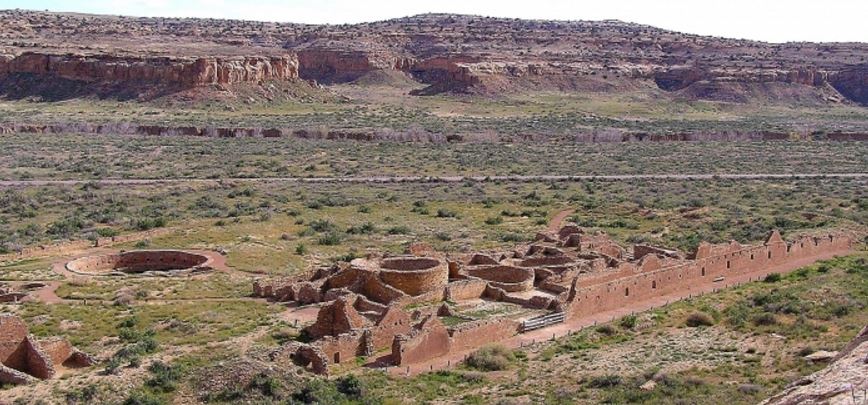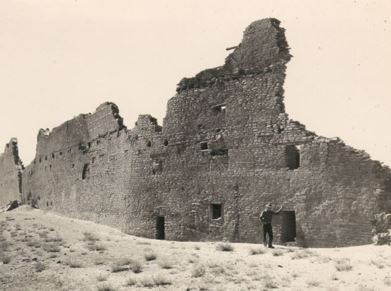The Chaco Canyon houses wood source mystery has finally been solved, say scientists from the University of Arizona Laboratory of Tree-Ring Research, who concluded that they came from two separate mountain ranges – Chuska and Zuni.
The researchers, who wrote about their study and conclusions in the academic journal Proceedings of the National Academy of Sciences, say they are the first to report that before the year 1020 AD, most of the Chaco Canyon houses were made from the wood that came from the Zuni Mountains, about 75 kilometres (50 miles) to the south.
The type of tree used to build the houses did not grow nearby, so they must have been transported from faraway mountain ranges.
 Chetro Ketl, built during the 10th-11th centuries, is one of the biggest great houses in Chaco Canyon, New Mexico. In spite of the harsh, high-desert environment, thousands of people once had their homes in and around what is now a World Heritage Site at Chaco Culture National Historical Park. (Image: University of Arizona. Credit: National Park Service)
Chetro Ketl, built during the 10th-11th centuries, is one of the biggest great houses in Chaco Canyon, New Mexico. In spite of the harsh, high-desert environment, thousands of people once had their homes in and around what is now a World Heritage Site at Chaco Culture National Historical Park. (Image: University of Arizona. Credit: National Park Service)
Chaco Canyon structures were enormous
Approximately 240,000 trees were used to build enormous structures, some of them five floors high, comprising hundreds of rooms, in New Mexico’s rocky, arid Chaco Canyon between 850 and 1140 AD.
The structures in the area include some of the largest buildings we know of in North America built before Christopher Columbus came to the New World.
Lead author Christopher Guiterman, a PhD student at UA’s School of Natural Resources and the Environment, said:
“The casual observer will see hundreds and hundreds and hundreds of beams sticking out of the walls. There’s wood all over the place in these structures. They’re built out of stone and wood.”
To determine where the wood for the beams came from, Guiterman used a method called ‘dendroprovenance’. The term comes from the Greek dendro, meaning ‘tree’, plus ‘provenance’, and refers to several scientific methods developed to determine where the parent tree of a given timber was growing when it was felled.
Switched to trees from Chuska Mountains by 1060
By 1060, the Chacoans had switched to using trees from the Chuska Mountains about 75 kilometres (50 miles) to the west.
Mr. Guiterman said the switch in wood sources coincided with several major developments in Chacoan culture.
 Chris Baisan checks the rings in a dead tree in New Mexico’s Chuska Mountains. The tree dates from the time that the ancient Puebloans were building colossal structures in Chaco Canyon, about 50 miles away. (Image: University of Arizona. Credit: Christopher H. Guiterman)
Chris Baisan checks the rings in a dead tree in New Mexico’s Chuska Mountains. The tree dates from the time that the ancient Puebloans were building colossal structures in Chaco Canyon, about 50 miles away. (Image: University of Arizona. Credit: Christopher H. Guiterman)
Mr. Guiterman explained:
“There’s a change in the masonry style – the architectural signature of the construction. There’s a massive increase in the amount of construction – about half of ‘downtown Chaco’ houses were built at the time the wood started coming from the Chuska Mountains.”
By gathering and analyzing data from archaeological records, the scientists found other materials coming to Chaco from the Chuskas at the same time.
Mr. Guiterman said:
“There’s pottery and there’s chipped-stone tools – things like projectile points and carving devices.”
This new study confirms previous research from the University of Arizona that used the chemistry of Chaco Canyon beams to determine that the wood came from Chuska Mountain trees.
To find out how ancient people interacted with Southwestern forests, Mr. Guiterman and Dr. Tom Swetnam decided to analyze the wood used in Chaco Canyon buildings.
 A 1930s photo showing the back wall of Pueblo Bonito, Chaco Canyon’s largest structure. Archaeologists estimate the intact building was five stories high and had about 500 rooms. It was built in phases from 850 to 1120. (Image: University of Arizona. Credit: George A. Grant/ National Park Service)
A 1930s photo showing the back wall of Pueblo Bonito, Chaco Canyon’s largest structure. Archaeologists estimate the intact building was five stories high and had about 500 rooms. It was built in phases from 850 to 1120. (Image: University of Arizona. Credit: George A. Grant/ National Park Service)
Analyzing annual growth rings to determine origin
They wondered whether the trees’ annual growth rings could reveal the origin of beams.Carrying out such a study would also test the results from the chemical method of determining where the wood came from.
So, Mr. Guiterman chose a technique used in Europe to determine the source of wood in artifacts – the dendroprovenance technique.
They had the required materials at hand: Laboratory of Tree-Ring Research founder A.E. Douglass, known as the founder of the modern science of dendrochronology, and Emil Haury, his student,had gathered wood from ancient Puebloan buildings and nearby mountain ranges across the Southwest starting in the 1920s, and used the material to date the major ruins of the Southwest.
Douglass’ and his student’s dated samples were archived in the basement of the lab, together with wood collected across the Southwest ever since by armies of archaeologists.
The lab’s archives contained scores of cardboard boxes with carefully labelled wood samples. According to Mr. Guiterman, there are over 6,000 wood specimens just from the Chaco Canyon great houses.
“We pulled stuff out of the archive that hasn’t been looked at in 30 or 40 years. It was pretty cool to open those boxes,” he said.
Tree rings reveal regional annual climate conditions
Trees’ annual growth rings tell you what the regional weather was like – in good-growing years the rings are wider, and thinner in bad ones. The patterns of thin-and-thick rings in the trees that grow in the mountain ranges surrounding Chaco Canyon are similar because the weather is the same.
However, conditions are marginally different in each mountain range, which means that the trees’ growth patterns are not identical.
To pinpoint the origin of the trees was a painstaking process. Mr. Guiterman had to compare the patterns on 170 different beams with archived tree-ring patterns from seven nearby mountain ranges.
A task that took four years to complete
Dr. Swetnam said:
“We think this is a powerful new method to use in the Southwest. We tested the method using modern trees and could determine their source of origin with 90 percent accuracy.”
Over 70% of the 170 timbers were from the Chuska or Zuni mountain ranges. According to Mr. Guiterman, the switch in the 11th century to the Chuskas coincided with the expansion of the Chacoan culture and indicates the cultural significance of that mountain range.
Mr. Guiterman said:
“We’re learning more and more about what these people did so long ago and how they utilized and interacted with their environment.”
In an Abstract in the journal. The authors concluded:
“Our findings, based on the most temporally specific and replicated evidence of Chacoan resource procurement obtained to date, corroborate the long-standing but recently challenged interpretation that large numbers of timbers were harvested and transported from distant mountain ranges to build the great houses at Chaco Canyon.”
The study was funded by the National Park Service and the Western National Parks Association.
Citation: “Eleventh-century shift in timber procurement areas for the great houses of Chaco Canyon,” Christopher H. Guiterman, Thomas W. Swetnam, and Jeffrey S. Dean. Proceedings of the National Academy of Sciences (PNAS). 7 December 2015. DOI: 10.1073/pnas.1514272112.
Video – Chaco Canyon, Why did the Chacoans leave?

